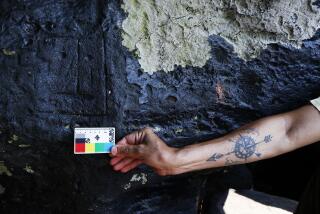This animal on a cave wall in Borneo is the oldest known figurative painting in the world
- Share via
In limestone caves hidden deep in the jungle of Borneo, archaeologists have discovered the oldest known figurative drawing created by a human artist, dating back at least 40,000 years.
The ancient artwork is incomplete, but appears to depict a large mammal — probably a type of wild cow — with an oval-shaped body, thin legs and a spear sticking out of its rump.
“To our knowledge, the large animal painting is the oldest figurative rock art in the world,” researchers reported Wednesday in the journal Nature.
The study authors noted that the painting, and others like it, were made at roughly the same time period as animal figurines carved from mammoth tusks that were discovered in west-central Germany.
This suggests that humans on opposite ends of Eurasia began creating figurative art at about the same time, they said.
But who these ancient Bornean artists were, whether they had a relationship with artists in the west, and what motivated them to leave their creative marks on the limestone caves remains a mystery.
“All we have at the moment is what they left on the cave walls,” said Maxime Aubert, an archaeologist at Griffith University in Australia who led the new work.
The Borneo cave paintings were discovered in a remote jungle region on the Indonesian side of the island by the French explorer Luc-Henri Fage in 1994.
Since then, archaeologists have documented thousands of paintings in dozens of cave sites in a mountainous part of Borneo that spans roughly 60 miles.
The caves are exceedingly difficult to explore. The route to the main site, Gua Saleh, involves paddling up a river by canoe, then walking for four long days in dense jungle.
“The cave is situated on the top of a mountain so it’s quite a hike,” Aubert said.
Once they reach the site, researchers can only stay for a few nights because water is scarce.
“We drink water dripping from a stalactite,” he said.
But the hardship is worth it. The cave opens up to a secret, untouched valley on the other side of the mountain.
“We can hear wildlife, including orangutans and all sorts of birds,” Aubert said. “Sometimes we see tiger prints or the occasional cobra.”
And of course, there are the paintings — mysterious pictorial messages from across time.
“It’s like they’re still talking to us,” Aubert said.

In the new work, the authors identify three distinct styles of painting that show up in the caves.
The earliest works are in a reddish-orange hue and include hand stencils and large pictures of animals — mostly the Bornean banteng, a type of wild cattle that can still be found on the island.
The next phase of paintings is dominated by works rendered in a dark purple color. These include clusters of hand stencils, some of which are filled in with painted lines, dashes or dots. The markings could represent tattoos or other forms of social identification, the authors said.
In some instances the hand stencils are linked together by lines, which might indicate a sort of family tree.
This phase also features small, carefully rendered drawings of humans often depicted in elaborate headdresses and an array of other objects. Some of them are shown in groups, either hunting or dancing.
The final rock art phase is characterized by human figures, boats and geometric designs executed in black pigments. The authors note that of the three, this is the only rock art style that has been found in other parts of Borneo and Indonesia.
To determine when these paintings were created, the researchers used a method called uranium-thorium dating that measures the age of calcitic crusts that form on the walls of caves.
By calculating the age of crusts that formed over the paintings, the authors were able to discern minimum ages for the artworks. If they were able to get a sample of the crust just beneath the painting, they were able to determine the maximum age of the art.
Over the course of two field seasons spent collecting crusts from the caves, the authors collected 15 calcium carbonate samples from 13 works of art at six separate cave sites.
This revealed that the earliest rock art phase in Borneo began sometime between 52,000 and 40,000 years ago. The second, dark-purple phase, appears to begin somewhere around 20,000 years ago. The final phase is likely significantly more recent, with art that was probably made in the past 4,000 years, the authors said.
Aubert said these findings have left the team puzzled.
In Europe, the start of figurative art coincides nicely with the arrival of early modern humans on the continent. But early modern humans arrived in Southeast Asia between 70,000 and 60,000 years ago, Aubert said. Why hasn’t any rock art been found that coincides with their arrival?
One possibility is that it exists but is still hidden, he said. Or perhaps there were two waves of human migrations to the area — one group that did not make rock art, and another 20,000 years later that did.
The authors also noted that the transition from depicting the animal world to the human world in the Borneo caves happens at about the same time as a similar transition in Europe.
Aubert said the team will return to the remote caves next year to begin archaeological excavations that may help them learn more about the unknown artists.
They also plan to date more rock art to narrow the time window for each phase.
Do you love science? I do! Follow me @DeborahNetburn and “like” Los Angeles Times Science & Health on Facebook.






